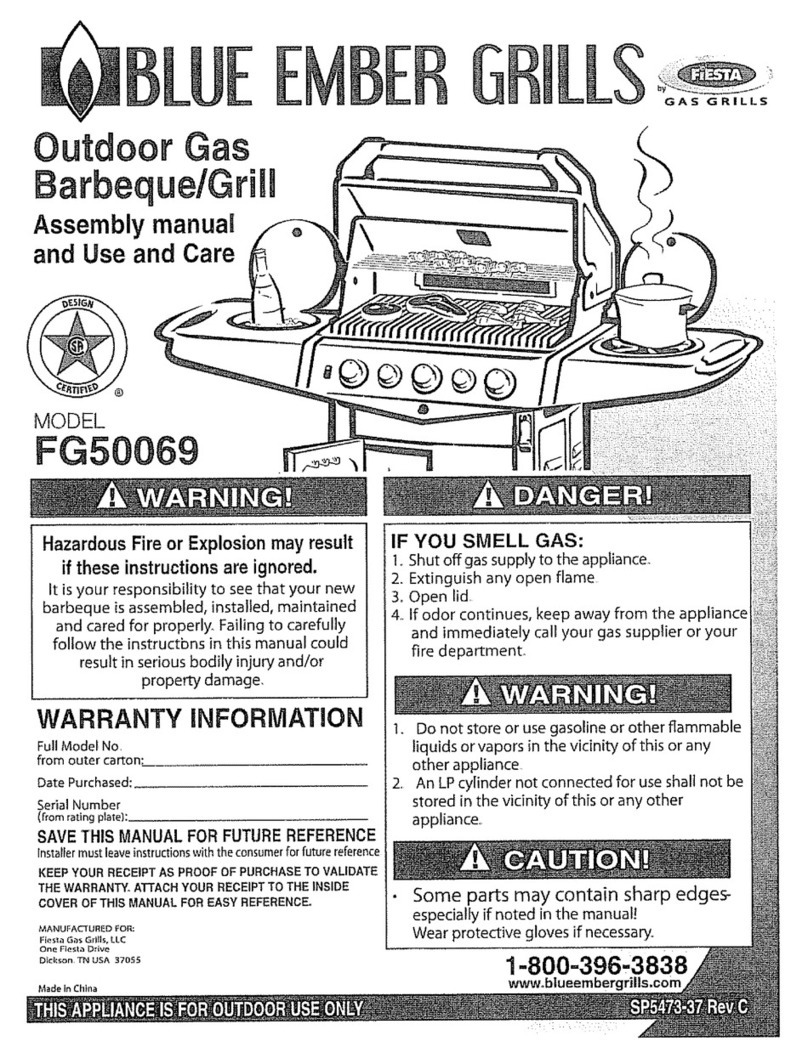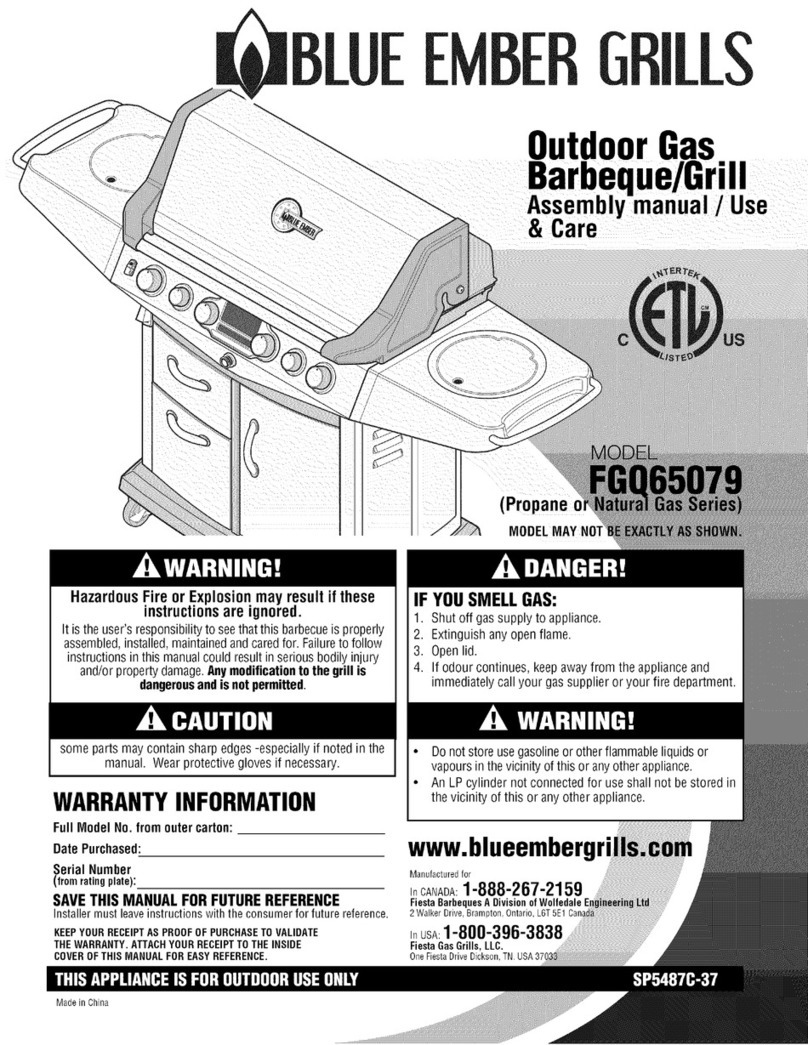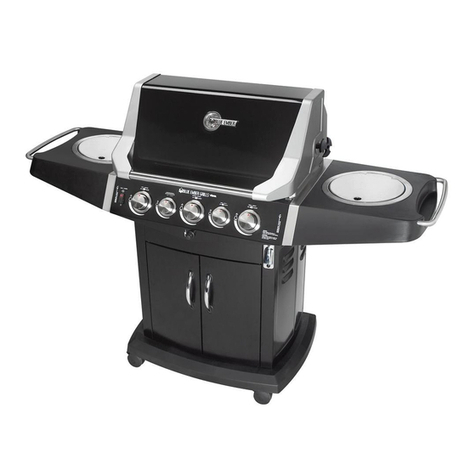
4
L.P. GAS CYLINDER
Gas cylinders manufactured today have mechanisms to provide worry
free barbequing year round:
Q.C.C.1 or Type 1-Quick Connect Coupling Valve, ensure fast tank hook-
ups requiring only hand tightening. The redundant valve system inhibits
the flow of gas to the burner if the connection is not 100% correct.
O.P.D. or Overfill Protection Device prevents accidental gas leaks
caused by cylinder “over pressurization”, the leading cause of cylinder
gas leaks. The float in the tank will automatically stop filling at 80%
capacity, leaving a 20% area for the expansion of liquid. Without this safety
feature, the relief valve may open and discharge propane, creating a
potential safety hazard. An O.P.D. cylinder is easily distinguished by its
triangular hand wheel valve. Figure 3)
Look for the Gas Guardian symbol
to easily identify propane cylinders
with these safety features.
1. SPECIFICATIONS
Self-contained propane gas
barbeque systems are designed to
be used only with a 9.1 kg (20 lb)
propane cylinder, equipped with a
Type 1 cylinder valve and
incorporating an overfill protection
device (O.P.D). This barbeque
cannot be connected to an existing
#510 P.O.L. type valve (ones with left-
hand threads). The cylinder for your
gas barbeque must be constructed
and marked in accordance with the
specifications of L.P. gas cylinders:
In Canada: The National Standards of Canada CAN/CSA-B339,
Cylinders, Spheres and Tubes for Transportation of Dangerous Goods;
and Commission.
In the U.S.: U.S. Department of Transportation (D.O.T.)
DO NOT CONNECT TO A PROPANE GAS CYLINDER EXCEEDING THIS
CAPACITY, OR USE A CYLINDER WITH ANY OTHER TYPE OF VALVE
CONNECTION DEVICE. The Type 1 valve is recognizable by the large
FILLING STOPS AT 80%
NEW OPD
HANDWHEEL
Fig. 3
O.P.D.
FLOAT
SAFETY:
• Always turn off the cylinder valve tightly when your barbeque is not in use.
• Handle tank valves with care.
• Never connect an unregulated L.P. gas cylinder to your barbeque.
• Never store a spare cylinder under or near your barbeque when in use.
• Never subject any cylinder to excessive heat or direct sunlight.
• Always keep your in-use cylinder securely fastened in an upright position.
• Do not insert any foreign objects into the valve outlet. You may damage
the back-check. A damaged back-check can be the source of a leak. Leaking
propane may result in explosion, fire, severe personal injury or death.
• Never fill the cylinder beyond 80% full.
external thread on the outlet part of the valve. Standard existing valves do
not have these exterior threads. Any attempt to connect a regulator, with other
than the:
i) Mating Type 1 connector (recognized by the large black coupling nut) or
ii) Standard #510 P.O.L. fitting,
by use of adapters or any other means, could result in damage, fire or injury
and may negate the important safety features designed into the Type 1
system. The connection of a #510 P.O.L. fitting will not provide the flow control
or temperature shut-off features built into the complete Type 1 system.
We strongly recommend use of a propane cylinder with Q.C.C.I and O.P.D.
safety features.
THE CYLINDER MUST ALSO BE EQUIPPED WITH:
a. A shut-off valve terminating in a proper cylinder valve outlet specified in
current standards:
• Canada: CAN/CGA - 1.6a - M98 - Outdoor Gas Grills - Amend.
• U.S.: ANSI Z 21.58a-1998 OUTDOOR COOKING APPLIANCES.
b. A listed overfilling protection device (O.P.D.).
c. A safety relief valve having direct communication with the vapor space of
the cylinder.
d. A collar to protect the tank shut off valve.
e. An arrangement for vapor withdrawal.
f. A bottom ring for securing to tank support assembly.
THE CYLINDER SHOULD NOT EXCEED 472 MM (18 1/2") IN HEIGHT AND 317
MM (12 1/2") IN DIAMETER.
ELECTRICAL CAUTION
• If any accessory installed on this barbeque requires an external
electrical power source, it must be electrically grounded in
accordance with local laws or in the absence of local laws, with
the Canadian Electrical Code CSA C22.1 or in the U.S., with the
National Electrical Code ANSI-NFPA 70.
• The three-prong plug provides protection against shock hazard
and should be plugged directly into a properly grounded
three-prong receptacle. Do not cut or remove the grounding
prong from this plug.
• To ensure continued protection against risk of electric shock,
connect to properly earthed outlets only.
• Ensure all electrical supply cords and fuel supply hoses are
kept well away from any heated surfaces.
CARING FOR YOUR EQUIPMENT
PROVIDING POWER TO YOUR BARBEQUE
To provide power to the barbecue, plug grounded electrical cord into
rear electrical box as shown. (Page 14, Fig.15)
Plug electrical cord into properly grounded
GFI (Ground Fault Interrupt) receptacle. If
use of an extension cord is required, be
sure that it is a minimum 16 AWG, 3 wire
well insulated cord, marked for OUTDOOR
USE ONLY and properly grounded. (Fig.14)
CAUTION: To ensure continued protection against risk of
electric shock, connect to properly earthed outlets only.
Fig. 14
WARNING
!
IF THE ABOVE INSTRUCTIONS
ARE NOT FOLLOWED EXACTLY,
A FIRE CAUSING DEATH OR
SERIOUS INJURY MAY OCCUR.





























